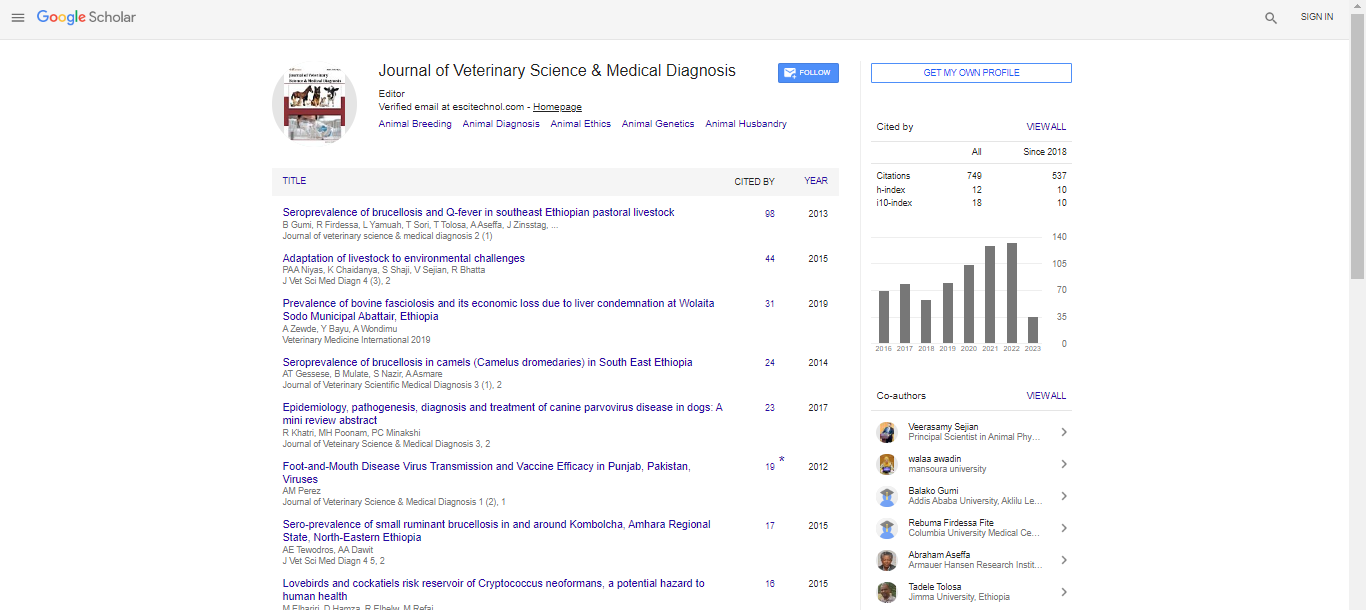Research Article, J Vet Sci Med Diagn Vol: 6 Issue: 4
Production of Camel Pox Vaccine in the Sudan
Fatima AT*, Nour TAM, Ballal A, Elhussein AM and Abdelmahmoud Atta AE
Viral vaccine production department, Veterinary research institute, Central Veterinary Research Laboratory, Khartoum, Sudan
*Corresponding Author : Fatima Abd Elazeem Taha
Viral vaccine production department, Central Veterinary Research Laboratory, Khartoum, Sudan
Tel: +00249129204275
E-mail: fatmaabdelazim@yahoo.com
Received: June 13, 2017 Accepted: September 06, 2017 Published: September 10, 2017
Citation: Fatima AT, Nour TAM, Ballal A, Elhussein AM, Abdelmahmoud Atta AE (2017) Production of Camel Pox Vaccine in the Sudan. J Vet Sci Med Diagn 6:4. doi: 10.4172/2325-9590.1000236
Abstract
Camels are important animals adapted to hot and arid environments, they represent an income to owner in rural areas hence, helping to upgrade the livelihood and alleviate poverty among people in these areas. Sudan ranks number two in camel’s population in the world, with more than 4 million heads of camel. The camel pox disease causes high morbidity (100%) and high mortality (10%-50%), especially in young animals. Effective control programs such as sanitary measures, quarantine of infected areas, restriction of camel movement, provision of clean drinking water and avoidance of skin abrasions are effective control measurements, unfortunately these methods are not applicable in Sudan owing to the migratory pattern of camel breeding in the country and difficulty to reach camels in remote area especially during the rainy season. In addition there is no treatment for camel pox disease, therefore, vaccination is regarded as the most effective tool for disease prevention. Few camel poxes both inactivated and live-attenuated vaccines are available in a few countries. Live vaccines are the best method as they provide long-lasting immunity. In the present study camel pox vaccine seed virus was obtained from African Union- Pan African Veterinary Vaccine Centre (AU.PANVAC) and successfully reproduced and evaluated in local lab condition and experimentally investigated in local host animals and environment. The vaccine was produced according to OIE manual and subjected for identity, safety, potency, efficacy and immunogenicity tests. The identity test for the vaccine master seeds was fulfilled as the first step using Varity of identification methods, Agar Gel Precipitation Test (AGPT), Virus Neutralization Test (VNT) and Polymarise Chain Reaction (PCR) tests. Moreover, sterility test was carried out for bacterial and fungal contaminations. The vaccine was produced using seed lot system i.e. Master Seed (MS) was used to produce the Working Seed Bank (WSB) from which an experimental batch was produced. All the production processes were carried out in an aseptic conditions using continuous cell line of African Green Monkey kidney cells (VERO). The safety profile for working seed lot was evaluated in host animal by inoculation of 10 camels obtained from local market with different age groups, animals were inoculated subcutaneously with 10 times the recommended field dose i.e.104 Tissue culture Infected Dose of fifty (TCID50) (OIE,2014). The immunogenicity of candidate vaccine was assessed in 20 healthy camels consequently, 14 camels were vaccinated by 103 TCID50 by S/C(OIE,2014) route and 6 were inoculated by phosphate buffer saline (PBS) and kept as un vaccinated control. The vaccine was safe and the inoculated animals remained healthy without any adverse reactions, neither signs of illness nor a rise in rectal temperature were recorded for up to 6 weeks post vaccination. The Abs mediated immune response i.e. immunogenicity was measured by serum neutralization test, the vaccinated camels demonstrated protective level of 5 (log2) Abs after 4 weeks post vaccination. While, no production of antibodies detected in the sera of the control group. After 4 weeks post vaccination all the vaccinated and control groups were challenged subcutaneously by local isolate of camel pox using 105.6 TClD50 / animal. Only the unvaccinated control group developed very severe clinical signs and fever reached 40oc with generalized and localized camel pox lesions, while the vaccinated groups withstood the test without death or clinical signs.
 Spanish
Spanish  Chinese
Chinese  Russian
Russian  German
German  French
French  Japanese
Japanese  Portuguese
Portuguese  Hindi
Hindi 
